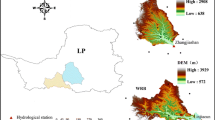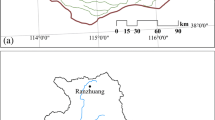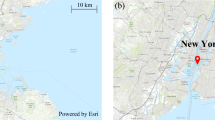Abstract
Bivariate frequency analysis is an emerging method for the assessment of compound floods, especially in coastal regions. Changing climate, which usually leads to changes in characteristics of extreme hydrometeorological phenomena, makes the application of nonstationary methods more critical. In this research, a methodology is developed to apply frequency analysis on extreme sea level using physically-based hydroclimatic variables as covariates based on univariate Generalized Extreme Value (GEV) as the probability distribution function and copula methods. The results show that for extreme sea level, the location parameter of marginal distribution is directly related to the covariate variable of maximum temperature. For precipitation, the scale parameter is related to the covariate variable of minimum temperature, and the shape parameter is time-dependent. The univariate return periods of hurricanes Sandy and Irene are estimated at 85 and 12 years in nonstationary GEV distribution, respectively, while for stationary GEV distribution they are estimated at 1200 and 25 years, and in the bivariate frequency analysis of water level and precipitation, the normal copula function has more flexibility compared to other competitors. Using time-varying copula, the bivariate return periods of Hurricanes Sandy and Irene are 109 years and 136 years, respectively. The results confirm the importance of incorporating rainfall and extreme sea level in coastal flood frequency analysis. Although the proposed methodology can be applied to other hydro-climatological variables, the findings of this research suggest the necessity of considering nonstationarity in the analysis of extreme hydrologic events.








Similar content being viewed by others
Data Availability
All data used to conduct this research are free and available to the public.
Code Availability
Some codes generated during this study are available by the corresponding author.
References
Abida H, Ellouze M (2008) Probability distribution of flood flows in Tunisia. Hydrol Earth Syst Sci 12(3):703–714. https://doi.org/10.5194/hess-12-703-2008
Ahn K-H, Palmer RN (2016) Use of a nonstationary copula to predict future bivariate low flow frequency in the Connecticut River basin. Hydrol Process 30(19):3518–3532. https://doi.org/10.1002/hyp.10876
Akbari S, Reddy MJ (2020) Non-stationarity analysis of flood flows using copula based change-point detection method: Application to case study of Godavari river basin. Science of the Total Environment 718:134894. https://doi.org/10.1016/j.scitotenv.2019.134894
Bayazit M (2015) Nonstationarity of hydrological records and recent trends in trend analysis: a state-of-the-art review. Environmental Processes 2:527–542. https://doi.org/10.1007/s40710-015-0081-7
Bevacqua E, Maraun D, Vousdoukas MI, Voukouvalas E, Vrac M, Mentaschi L, Widmann M (2019) Higher probability of compound flooding from precipitation and storm surge in Europe under anthropogenic climate change. Science Advances 5:eaaw5531. https://doi.org/10.1126/sciadv.aaw5531
Blanton B, Dresback K, Colle B, Kolar R, Vergara H, Hong Y, Leonardo N, Davidson R, Nozick L, Wachtendorf T (2018) An integrated scenario ensemble-based framework for hurricane evacuation modeling: Part 2-hazard modeling. Risk Anal 40(1):117–133. https://doi.org/10.1111/risa.13004
Brown SJ, Murphy JM, Sexton DMH, Harris GR (2014) Climate projections of future extreme events accounting for modelling uncertainties and historical simulation biases. Clim Dyn 43:2681–2705. https://doi.org/10.1007/s00382-014-2080-1
Cantet P, Arnaud P (2014) Extreme rainfall analysis by a stochastic model: impact of the copula choice on the sub-daily rainfall generation. Stoch Env Res Risk Assess 28(6):1479–1492. https://doi.org/10.1007/s00477-014-0852-0
Chebana F, Ouarda TB (2011) Multivariate quantiles in hydrological frequency analysis. Environmetrics 22(1):63–78. https://doi.org/10.1002/env.1027
Chebana F, Ouarda TB, Duong TC (2013) Testing for multivariate trends in hydrologic frequency analysis. J Hydrol 486:519–530. https://doi.org/10.1016/j.jhydrol.2013.01.007
Cheng L, AghaKouchak A, Gilleland E (2014) Non-stationary extreme value analysis in a changing climate. Clim Change 127:353–369. https://doi.org/10.1007/s10584-014-1254-5
Coles S (2001) An introduction to statistical modeling of extreme values. Springer, London. https://doi.org/10.1007/978-1-4471-3675-0
Dong ND, Agilan V, Jayakumar KV (2019) Bivariate flood frequency analysis of nonstationary flood characteristics. J Hydrol Eng 24(4):04019007. https://doi.org/10.1061/(asce)he.1943-5584.0001770
Du TL, Xiong CY, Xu CJ, Gippel SG, Liu P (2015) Return period and risk analysis of nonstationary low flow series under climate change. J Hydrol 527:234–250. https://doi.org/10.1016/j.jhydrol.2015.04.041
Fang J, Wahl T, Fang J, Sun X, Kong F, Liu M (2020) Compound flood potential from storm surge and heavy precipitation in coastal China. Hydrology and Earth System Sciences Discussions 1–24. 10.5194/hess-2020-377
Faulkner D, Warren S, Spencer P, Sharkey P (2019) Can we still predict the future from the past: Implementing non-stationary flood frequency analysis in the UK. Journal of Flood Risk Management 13(1). https://doi.org/10.1111/jfr3.12582
Feng Y, Shi P, Qu S, Mou S, Chen C, Dong F (2020) Nonstationary flood coincidence risk analysis using time-varying copula functions. Scientific Reports 10(1). https://doi.org/10.1038/s41598-020-60264-3
Ferrer J, P´erez-Mart´ın MA, Jim´enez S, Estrela T, Andreu J, (2012) GIS-based models for water quantity and quality assessment in the j´ucar river basin, Spain, including climate change effects. Sci Total Environ 440:42–59. https://doi.org/10.1016/j.scitotenv.2012.08.032
Fowler HJ, Cooley D, Sain SR, Thurston M (2010) Detecting change in UK extreme precipitation using results from the climate prediction net BBC climate change experiment. Extremes 13:241–267. https://doi.org/10.1007/s10687-010-0101-y
Fréchet M (1928) Sur la lois de probabilité de l’´ecart maximum. Annales de la Societé Polonaise de Mathématique 6:93–122. http://cybra.lodz.pl/Content/6198/AnnSocPolMathe_t.VI_1927.pdf. Accessed 20-01-2022
Galiatsatou P, Makris C, Prinos P, Kokkinos D (2019) Nonstationary joint probability analysis of extreme marine variables to assess design water levels at the shoreline in a changing climate. Nat Hazards 98(3):1051–1089. https://doi.org/10.1007/s11069-019-03645-w
Ganguli P, Merz B (2019) Trends in compound flooding in northwestern Europe during 1901–2014. Geophys Res Lett 46:10810–10820. https://doi.org/10.1029/2019GL084220
Garner AJ, Mann ME, Emanuel KA, Kopp RE, Lin N, Alley RB, Horton BP, DeConto RM, Donnelly JP, Pollard D (2017) Impact of climate change on New York city’s coastal flood hazard: Increasing flood heights from the preindustrial to 2300 CE. Proc Natl Acad Sci 114(45):11861–11866. https://doi.org/10.1073/pnas.1703568114
Gilroy KL, McCuen RH (2012) A nonstationary flood frequency analysis method to adjust for future climate change and urbanization. J Hydrol 414–415:40–48. https://doi.org/10.1016/j.jhydrol.2011.10.009
Goharian E, Burian SJ, Bardsley T, Strong C (2016) Incorporating potential severity into vulnerability assessment of water supply systems under climate change conditions. J Water Resour Plan Manag 142(2):04015051. https://doi.org/10.1061/(asce)wr.1943-5452.0000579
Golian S, Saghafian B, Farokhnia A (2012) Copula-based interpretation of continuous rainfall–runoff simulations of a watershed in northern iran. Can J Earth Sci 49(5):681–691. https://doi.org/10.1139/e2012-011
Graler B, van den Berg MJ, Vandenberghe S, Petroselli A, Grimaldi S, Baets BD, Verhoest NEC (2013) Multivariate return periods in hydrology: a critical and practical review focusing on synthetic design hydrograph estimation. Hydrol Earth Syst Sci 17(4):1281–1296. https://doi.org/10.5194/hess-17-1281-2013
Griffin A, Vesuviano G, Stewart E (2019) Have trends changed over time? A study of UK peak flow data and sensitivity to observation period. Nat Hazard 19(10):2157–2167. https://doi.org/10.5194/nhess-19-2157-2019
Gumbel EJ (1958) Statistics of Extremes. Columbia University Press, New York Chichester, West Sussex. https://doi.org/10.7312/gumb92958
Guo E, Zhang J, Si H, Dong Z, Cao T, Lan W (2016) Temporal and spatial characteristics of extreme precipitation events in the Midwest of Jilin province based on multifractal detrended fluctuation analysis method and copula functions. Theoret Appl Climatol 130(1–2):597–607. https://doi.org/10.1007/s00704-016-1909-4
Hafner CM, Manner H (2008) Dynamic stochastic copula models: estimation, inference and applications. METEOR, Maastricht University, Maastricht Research School of Economics of Technology and Organization, METEOR Research Memorandum No.043. https://doi.org/10.26481/umamet.2008043
Hawkes PJ, Gonzalez-Marco D, S´anchez-Arcilla A, Prinos P, (2008) Best practice for the estimation of extremes: A review. J Hydraul Res 46(sup2):324–332. https://doi.org/10.1080/00221686.2008.9521965
Hendry A, Haigh ID, Nicholls RJ, Winter H, Neal R, Wahl T, Joly-Laugel A, Darby SE (2019) Assessing the characteristics and drivers of compound flooding events around the UK coast. Hydrol Earth Syst Sci 23:3117–3139. https://doi.org/10.5194/hess-23-3117-2019
Herdman L, Erikson L, Barnard P (2018) Storm surge propagation and flooding in small tidal rivers during events of mixed coastal and fluvial influence. Journal of Marine Science and Engineering 6(4):158. https://doi.org/10.3390/jmse6040158
Ikeuchi H, Hirabayashi Y, Yamazaki D, Muis S, Ward PJ, Winsemius HC, Verlaan M, Kanae S (2017) Compound simulation of fluvial floods and storm surges in a global coupled river-coast flood model: Model development and its application to 2007 cyclone sidr in bangladesh. Journal of Advances in Modeling Earth Systems 9(4):1847–1862. https://doi.org/10.1002/2017ms000943
Jiang C, Xiong L, Xu CY, Guo S (2014) Bivariate frequency analysis of nonstationary low-flow series based on the time-varying copula. Hydrol Process 29(6):1521–1534. https://doi.org/10.1002/hyp.10288
Kang L, Jiang S, Hu X, Li C (2019) Evaluation of return period and risk in bivariate non-stationary flood frequency analysis. Water 11(1):79. https://doi.org/10.3390/w11010079
Karamouz M, Farzaneh H (2020) Margin of safety based flood reliability evaluation of wastewater treatment plants: Part 2-quantification of reliability attributes. Water Resour Manage 34(6):2043–2059. https://doi.org/10.1007/s11269-020-02543-2
Karamouz M, Fereshtehpour M, Ahmadvand F, Zahmatkesh Z (2016) Coastal flood damage estimator: An alternative to FEMA’s HAZUS platform. Journal of Irrigation and Drainage Engineering 142(6). https://doi.org/10.1061/(asce)ir.1943-4774.0001017
Karamouz M, Razmi A, Nazif S, Zahmatkesh Z (2017) Integration of inland and coastal storms for flood hazard assessment using a distributed hydrologic model. Environmental Earth Sciences 76(11). https://doi.org/10.1007/s12665-017-6722-6
Katz RW (2013) Statistical methods for nonstationary extremes. In: A. AghaKouchak, et al., eds. Extremes in a changing climate: detection, analysis and uncertainty. Dordrecht: Springer Science Business media. https://doi.org/10.1007/978-94-007-4479-0
Kirkpatrick JIM, Olbert AI (2020) Modelling the effects of climate change on urban coastal-fluvial flooding. Journal of Water and Climate Change 11(S1):270–288. https://doi.org/10.2166/wcc.2020.166
Kron W (2005) Flood risk = hazard values vulnerability. Water International 30(1):58–68. https://doi.org/10.1080/02508060508691837
Lai Y, Li J, Gu X, Liu C, Chen YD (2021) Global compound floods from precipitation and storm surge: hazards and the roles of cyclones. J Clim 34(20):8319–8339. https://doi.org/10.1175/JCLI-D-21-0050.1
Lee C, Hwang S, Do K, Son S (2019) Increasing flood risk due to river runoff in the estuarine area during a storm landfall. Estuar Coast Shelf Sci 221:104–118. https://doi.org/10.1016/j.ecss.2019.03.021
Li H, Wang D, Singh VP, Wang Y, Wu J, Wu J, Liu J, Zou Y, He R, Zhang J (2019) Nonstationary frequency analysis of annual extreme rainfall volume and intensity using Archimedean copulas: a case study in eastern china. J Hydrol 571:114–131. https://doi.org/10.1016/j.jhydrol.2019.01.054
Libiseller C, Grimvall A (2002) Performance of partial Mann-Kendall tests for trend detection in the presence of covariates. Environmetrics 13(1):71–84. https://doi.org/10.1002/env.507
Lin N, Emanuel K, Oppenheimer M, Vanmarcke E (2012) Physically based assessment of hurricane surge threat under climate change. Nat Clim Chang 2(6):462–467. https://doi.org/10.1038/nclimate1389
Lin N, Kopp RE, Horton BP, Donnelly JP (2016) Hurricane Sandy’s food frequency increasing from year 1800 to 2100. PNAS 113(43):12071. https://doi.org/10.1073/pnas.1604386113
Lopez J, Frances F (2013) Non-stationary flood frequency analysis in continental Spanish rivers, using climate and reservoir indices as external covariates. Hydrol Earth Syst Sci 17:3189–3203. https://doi.org/10.5194/hess-17-3189-2013
Lu F, Song X, Xiao W, Zhu K, Xie Z (2020) Detecting the impact of climate and reservoirs on extreme floods using nonstationary frequency models. Stoch Env Res Risk Assess 34:169–182. https://doi.org/10.1007/s00477-019-01747-2
Luo Y, Zhu LS (2019) Investigation of trends in extreme significant wave heights in the South China Sea. Aquat Ecosyst Health Manage 22(1):53–64. https://doi.org/10.1080/14634988.2018.1467194
Machado MJ, Botero BA, L´opez J, Franc´es F, D´ıez-Herrero A, Benito G, (2015) Flood frequency analysis of historical flood data under stationary and non-stationary modelling. Hydrol Earth Syst Sci 12:525–568. https://doi.org/10.5194/hessd-12-525-2015
Manner H, Candelon B (2010) Testing for asset market linkages: A new approach based on time-varying copulas. Pac Econ Rev 15(3):364–384. https://doi.org/10.1111/j.1468-0106.2010.00508.x
Milly PCD, Wetherald RT, Dunne KA, Delworth TL (2002) Increasing risk of great floods in a changing climate. Nature 415(6871):514–517. https://doi.org/10.1038/415514a
Moftakhari HR, Salvadori G, AghaKouchak A, Sanders BF, Matthew RA (2017) Compounding effects of sea level rise and fluvial flooding. Proceedings of the National Academy of Sciences, USA 114:9785–9790. https://doi.org/10.1073/pnas.1620325114
Mudersbach C, Jensen J (2010) Nonstationary extreme value analysis of annual maximum water levels for designing coastal structures on the German north sea coastline. Journal of Flood Risk Management 3(1):52–62. https://doi.org/10.1111/j.1753-318x.2009.01054.x
Nelsen RB (2006) An Introduction to Copulas. Springer, New York. https://doi.org/10.1007/0-387-28678-0
Ouarda TB, Charron C (2019) Changes in the distribution of hydro-climatic extremes in a non-stationary framework. Sci Rep 9:8104. https://doi.org/10.1038/s41598-019-44603-7
Pasquier U, He Y, Hooton S, Goulden M, Hiscock KM (2018) An integrated 1d–2d hydraulic modelling approach to assess the sensitivity of a coastal region to compound flooding hazard under climate change. Nat Hazards 98(3):915–937. https://doi.org/10.1007/s11069-018-3462-1
Patton AJ (2006) Modelling asymmetric exchange rate dependence. Int Econ Rev 47(2):527–556. https://doi.org/10.1111/j.1468-2354.2006.00387.x
Pickands J (1975) Statistical inference using extreme order statistics. The Annals of Statistics 3(1). https://doi.org/10.1214/aos/1176343003
Pirani FJ, Najafi MR (2020) Recent trends in individual and multivariate compound flood drivers in Canada's coasts. Water Resources Research 56(8). https://doi.org/10.1029/2020wr027785
Prosdocimi I, Kjeldsen T (2021) Parametrization of change-permitting extreme value models and its impact on the description of change. Stoch Env Res Risk Assess 35:307–324. https://doi.org/10.1007/s00477-020-01940-8
Razmi A, Golian S, Zahmatkesh Z (2017) Non-stationary frequency analysis of extreme water level: Application of annual maximum series and peak-over threshold approaches. Water Resour Manage 31(7):2065–2083. https://doi.org/10.1007/s11269-017-1619-4
Roussas G (2014) Introduction to Probability 2nd edition. Academic Press, Boston. https://doi.org/10.1016/B978-0-12-800041-0.00014-6
Roux E, Evin G, Eckert N, Blanchet J, Morin S (2020) Non-stationary extreme value analysis of ground snow loads in the French Alps: a comparison with building standards. Nat Hazard 20:2961–2977. https://doi.org/10.5194/nhess2020-81
Saleh F, Ramaswamy V, Wang Y, Georgas N, Blumberg A, Pullen J (2017) A multi-scale ensemble-based framework for forecasting compound coastal-riverine flooding: The hackensack-passaic watershed and Newark bay. Adv Water Resour 110:371–386. https://doi.org/10.1016/j.advwatres.2017.10.026
Sarhadi A, Soulis ED (2017) Time-varying extreme rainfall intensity-duration-frequency curves in a changing climate. Geophys Res Lett 44(5):2454–2463. https://doi.org/10.1002/2016gl072201
Sarhadi A, Burn DH, Aus´ın MC, Wiper MP, (2016) Time-varying nonstationary multivariate risk analysis using a dynamic bayesian copula. Water Resour Res 52(3):2327–2349. https://doi.org/10.1002/2015wr018525
Serinaldi F, Kilsby CG (2015) Stationarity is undead: uncertainty dominates the distribution of extremes. Adv Water Resour 77:17–36. https://doi.org/10.1016/j.advwatres.2014.12.013
Shrestha PL, James SC, Shaller PJ, Doroudian M, Peraza DB, Morgan TA (2014) Estimating the storm surge recurrence interval for hurricane sandy. In World Environmental and Water Resources Congress 2014. American Society of Civil Engineers. https://doi.org/10.1061/9780784413548.191
Singh H, Najafi MR, Cannon AJ (2021) Characterizing non-stationary compound extreme events in a changing climate based on large-ensemble climate simulations. Clim Dyn 56:1389–1405. https://doi.org/10.1007/s00382-020-05538-2
Singh VP, Strupczewski WG (2002) On the status of flood frequency analysis. Hydrol Process 16(18):3737–3740. https://doi.org/10.1002/hyp.5083
Sklar A (1959) Fonctions de répartition à n dimensions et leurs marges. Publications de l´Institut de Statistique de l' Université de Paris 8:229–231
Song JB, Wei EB, Hou YJ (2004) Joint statistical distribution of two-point sea surface elevations in finite water depth. Coast Eng 50(4):169–179. https://doi.org/10.1016/j.coastaleng.2003.09.006
Svensson C, Kundzewicz WZ, Maurer T (2005) Trend detection in river flow series: 2. flood and low-flow index series / d´etection de tendance dans des s´eries de d´ebit fluvial: 2. s´eries d'indices de crue etd'´etiage. Hydrological Sciences Journal 50(5). https://doi.org/10.1623/hysj.2005.50.5.811
Tsakiris G, Kordalis N, Tsakiris V (2015) Flood double frequency analysis: 2d-archimedean copulas vs bivariate probability distributions. Environmental Processes 2:705–716. https://doi.org/10.1007/s40710-015-0078-2
Wahl T, Jain S, Bender J, Meyers SD, Luther ME (2015) Increasing risk of compound flooding from storm surge and rainfall for major US cities. Nat Clim Chang 5(12):1093–1097. https://doi.org/10.1038/nclimate2736
Wahlin K, Grimvall A (2009) Roadmap for assessing regional trends in groundwater quality. Environ Monit Assess 165(1–4):217–231. https://doi.org/10.1007/s10661-009-0940-7
Wang S (2020) Uncertainties in the assessment of individual and compound flooding from river discharge and coastal water levels under climate change. Electronic Thesis and Dissertation Repository: 551, University of Western Ontario. https://ir.lib.uwo.ca/etd/7551. Accessed 20-01-2022
Wen T, Jiang C, Xu X (2019) Nonstationary analysis for bivariate distribution of flood variables in the Ganjiang river using time-varying copula. Water 11(4):746. https://doi.org/10.3390/w11040746
Xavier ACF, Blain GC, Morais MV, Sobierajski GR (2019) Selecting “the best” nonstationary Generalized Extreme Value (GEV) distribution: on the influence of different numbers of GEV-models. Bragantia 78(4):606–621. https://doi.org/10.1590/1678-4499.20180408
Xu K, Ma C, Lian J, Bin L (2014) Joint probability analysis of extreme precipitation and storm tide in a coastal city under changing environment. PLoS ONE 9(10):e109341. https://doi.org/10.1371/journal.pone.0109341
Xu P, Wang D, Singh VP, Wang Y, Wu J, Lu H, Wang L, Liu J, Zhang J (2019) Time-varying copula and design life level-based nonstationary risk analysis of extreme rainfall events. Hydrology and Earth System Sciences, Accepted Manuscript. https://doi.org/10.5194/hess-2019-358
Yan L, Xiong L, Guo S, Xu C-Y, Xia J, Du T (2017) Comparison of four nonstationary hydrologic design methods for changing environment. J Hydrol 551:132–150. https://doi.org/10.1016/j.jhydrol.2017.06.001
Ye F, Zhang Y, Yu H, Sun W, Moghimi S, Myers E, Nunez MK, Zhang R, Wang H, Roland A, Martins K, Bertin X, Du J, Liu Z (2019) Simulating storm surge and compound flooding events with a creek-to-ocean model: Importance of baroclinic effects. Ocean Model 145:101526. https://doi.org/10.1016/j.ocemod.2019.101526
Yoon J-H, Wang S-YS, Gillies RR, Kravitz B, Hipps L, Rasch PJ (2015) Increasing water cycle extremes in California and in relation to ENSO cycle under global warming. Nature Communications 6(1). https://doi.org/10.1038/ncomms9657
Zahmatkesh Z, Burian SJ, Karamouz M, Tavakol-Davani H, Goharian E (2015a) Low-impact development practices to mitigate climate change effects on urban stormwater runoff: Case study of New York City. J Irrig Drain Eng 141(1):04014043. https://doi.org/10.1061/(asce)ir.1943-4774.0000770
Zahmatkesh Z, Karamouz M, Goharian E, Burian SJ (2015b) Analysis of the effects of climate change on urban storm water runoff using statistically downscaled precipitation data and a change factor approach. J Hydrol Eng 20(7):05014022. https://doi.org/10.1061/(asce)he.1943-5584.0001064
Zellou B, Rahali H (2019) Assessment of the joint impact of extreme rainfall and storm surge on the risk of flooding in a coastal area. J Hydrol 569:647–665. https://doi.org/10.1016/j.jhydrol.2018.12.028
Zhang T, Wang Y, Wang B, Tan S, Feng P (2018) Nonstationary flood frequency analysis using univariate and bivariate time-varying models based on GAMLSS. Water 10(7):819. https://doi.org/10.3390/w10070819
Zhang YJ, Ye F, Yu H (2020) Simulating compound flooding events in a hurricane. Ocean Dyn 70:621–640. https://doi.org/10.1007/s10236-020-01351-x
Zscheischler J, Westra S, van den Hurk BJJM, Seneviratne SI, Ward PJ, Pitman A, AghaKouchak A, Bresch DN, Leonard M, Wahl T, Zhang X (2018) Future climate risk from compound events. Nat Clim Chang 8(6):469–477. https://doi.org/10.1038/s41558-018-0156-3
Funding
The authors did not receive support from any organization for the submitted work.
Author information
Authors and Affiliations
Contributions
Ali Razmi, Heydar Ali Mardani-Fard, and Saeed Golian designed the framework and analyzed the data. Heydar Ali Mardani-Fard and Ali Razmi performed the analysis and modeling. Zahra Zahmatkesh wrote the manuscript with support from Heydar Ali Mardani-Fard and Saeed Golian. Zahra Zahmatkesh and Saeed Golian supervised the research. All authors discussed the results and contributed to the final manuscript.
Corresponding author
Ethics declarations
Conflicts of interest/Competing interests
Not Applicable.
Additional information
Publisher's note
Springer Nature remains neutral with regard to jurisdictional claims in published maps and institutional affiliations.
Supplementary Information
Below is the link to the electronic supplementary material.
Rights and permissions
About this article
Cite this article
Razmi, A., Mardani-Fard, H.A., Golian, S. et al. Time-Varying Univariate and Bivariate Frequency Analysis of Nonstationary Extreme Sea Level for New York City. Environ. Process. 9, 8 (2022). https://doi.org/10.1007/s40710-021-00553-9
Received:
Accepted:
Published:
DOI: https://doi.org/10.1007/s40710-021-00553-9




